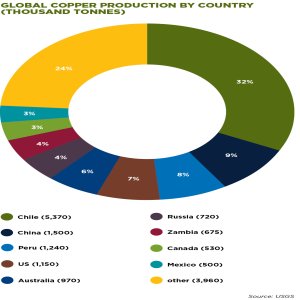Pan American Silver Bases Growth Streak in Mexico

STORY INLINE POST
Many of the best performing silver mining companies are relatively young companies that use new business models relying on state of the art operational practices. Perhaps one of the most representative examples of this trend is Pan American Silver. This Canadian-based company has become the third largest primary silver mining company in the world, after only 19 years of operation (as per production figures published by The Silver Institute). Pan American Silver produced a company record of 25.1 million ounces of silver and 112,300 ounces of gold in 2012.
Pan American Silver owns seven silver-producing mines in Mexico, Peru, Bolivia, and Argentina, plus a variety of exploration and development projects. Its largest silverproducing mine, Alamo Dorado, is located in Mexico, and ranks as one of the 15 most important primary silver mines in the world. This asset, located in the southwestern region of Sonora, started producing in 2007 and its total production for the last three years (2010 to 2012) surpasses 17 million ounces of silver. Chris Warwick, Country Manager of Pan American Silver, and CEO of its Mexican subsidiary Plata Panamericana (PASMEX), has a good perspective on the opportunities for mining companies that own projects in Mexico. “The Mexican mining industry is in a strong position, built on strong prices and attractive mining opportunities under the previous government,” Warwick mentions. “This may be compromised going forward as metal prices soften and the new government introduces new forms of taxation for the industry, but it will still leave a robust operating environment,” he affirms.
Pan American Silver’s producing mines in Mexico are now the biggest contributors to the company’s global silver output. Its fully-operating asset in Zacatecas, La Colorada, has produced 12.4 million ounces of silver over the past three years. Together, Alamo Dorado and La Colorada produced over 9.8 million ounces of silver during 2012, which represented 39% of the company’s global silver production. Additionally, the company added the Dolores project, located in Chihuahua, to its portfolio as a result of the acquisition of Minefinders Ltd. By the end of 2012, the mine had already yielded 2.7 million ounces of silver. Furthermore, Pan American Silver is developing another project resulting from this acquisition, and is exploring Minefinders’ assets in Northern Sonora.
PASMEX expects to increase silver production in Mexico to between 12.6 and 13.1 million ounces of silver by the end of 2013, while at the same time streamlining new projects and increasing Pan American Silver’s global reserves. The company’s strategy is to extend mine life through exploration, generate new projects as a result of important discoveries and acquisitions, and achieve operational stability and reliability by virtue of sound mining methods and community engagement. “Mine life, coupled with sound capital investments, has been the key to making PASMEX the largest contributor to Pan American Silver’s worldwide production, as it has been the platform to build on,” Warwick says. “This has allowed the implementation of strong mining philosophies, which have not been compromised in the buildup of production over the previous years.”
Pan American Silver’s particular attention to the mining method employed in each individual operation helps the company balance exploration, development, and production successfully. Furthermore, the company places great importance on community relations and sustainability. For example, the company has teamed up with the National Institute for Forestry, Agriculture and Livestock (INIFAP) to design sustainable agricultural projects that could guarantee a means of living for the population that inhabits the arid area surrounding the Alamo Dorado project. “Our commitment to the local communities has shown PASMEX to be a serious player in the areas of its operations,” Warwick affirms. “This has filtered through to the employees from those areas and has resulted in very energetic committed workforces who are proud of their individual operation.”
Warwick believes that water management, both in underground and surface mining, is and has always been the most notable environmental challenge in Mexican mining operations. He notes that even the water that simply passes through a mine’s property from a river or as a result of storm water run-off must be respected. “Water is always linked to the surrounding communities, their farming and livestock. The ejidos can turn hostile very quickly if not given the correct attention in the management of their water,” he warns.
While Warwick admits that the possible approval of a royalty tax could be a challenge and a possible cause of the industry’s deflation, he affirms that PASMEX maintains considerable ambitions in the country. “We will continue looking for further growth through future acquisitions,” he mentions. “At the same time, we will also continue to foster the growth of existing operations.”
The La Colorada mine is located in the Chalchihuites district in Zacatecas State, and is comprised of three separate underground silver mines covering an area of approximately 2,864 hectares. The La Colorada mine is a typical epithermal silver-gold deposit, with a transition in the lower reaches of the deposit to a more base metal predominant system. In 2013 Pan American Silver anticipates producing between 4.6 million and 4.7 million ounces of silver, between 4,300 and 4,500oz of gold, between 5,000 and 5,800 tonnes of zinc, and between 2,800 and 2,900 tonnes of lead.





















